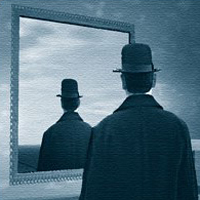I love browsing charity shops and second-hand bookstores. At the moment, I’m going to The Port Adelaide Emporium. Set over three dusty floors, it smells of furniture polish and creaks like an old wooden ship. It’s full of stuff that you’d never intentionally go out to buy.
As soon as you walk in, you’re met by cabinets stuffed full of crystals, copper pots and miniature violins, while up the stairs is Aboriginal art from the Northern Territories, next to Jayne Mansfield posters and botanical watercolours.
Down in the basement, there are fertility amulets carved out of fern roots; tiki masks; gentlemen’s pipes; collectible spoons and brightly painted Japanese fans. And, of course, lots and lots of books. It’s a chaotic place, yet you always end up leaving with a bag-full.
What’s great about the Emporium is that the idea of the ‘incidental finding’ has been written in to the very fabric of the shop. The owner sells her books in bundles of three, but only she knows how the books are related to one another, and you have to ask to find out.
For example, if you buy the official autobiography of Bruce Lee, you get chicken soup recipes and meditation for beginners, because all three, according to the owner, are self-improvement books. All of her books are organised this way, and it can be truly mind-opening.
Incidentalomas are a GP’s nightmare because they make us confront the great yawning chasm of our own ignorance
When I was last there, I spotted a textbook on radiology. I hadn’t opened one of those since medical school, but was intruiged by the front cover image – the X-ray of Bertha Röentgens’ hand.
Starkly black and white with a wedding ring firmly on the finger, Bertha’s hand is one of the defining images of medical science and a powerful symbol of scientific surety.
But how were the Röentgens to know that X-rays would end up creating victims out of patients? The incidentaloma is everywhere and every GP’s nightmare. Why? It makes us confront the great yawning chasm of our own ignorance.
How the hell should I know what to do with a pancreatic cyst? And don’t ask me what a Reidel’s lobe actually is – I haven’t opened up a radiology textbook since finals!
This text was paired with Ray Reardon’s ‘50 Best Trick Shots’ and ‘Who was Steve Irwin?’ by Tomie dePaola.
But, as in the Emporium, the incidental finding isn’t always bad. I recently admitted a patient with suspected appendicitis, and the junior doctor working in A&E ordered a CT scan.
This ended up showing a completely normal appendix, but a completely abnormal renal mass. Two weeks later, she had a lifesaving nephrectomy and made an astonishing recovery.
She doesn’t believe in overinvestigation, VOMITS (victims of medical imaging technology) or even coincidences. She believes in fate, guardian angels, the certainty of chance and synchronicity – the name given by Jung to describe meaningful coincidences. The cause for her abdominal pain, which only lasted for a day and a half, was never found.
As I was leaving the shop, I asked the owner what connected the three books. She told me it was rays – Ray Reardon the snooker player, X-rays, and, in the case of Steve Irwin, stingrays (sorry Steve). Finding an incidental renal tumour or being stabbed through the heart by a stingray are rare, chance events, and so, before leaving the Emporium, I bought a Turkish Nazar and a smiling Buddha, just for luck.
Dr Kevin Hinkley is a GP in Australia who previously practised in Glasgow and Aberdeen

















